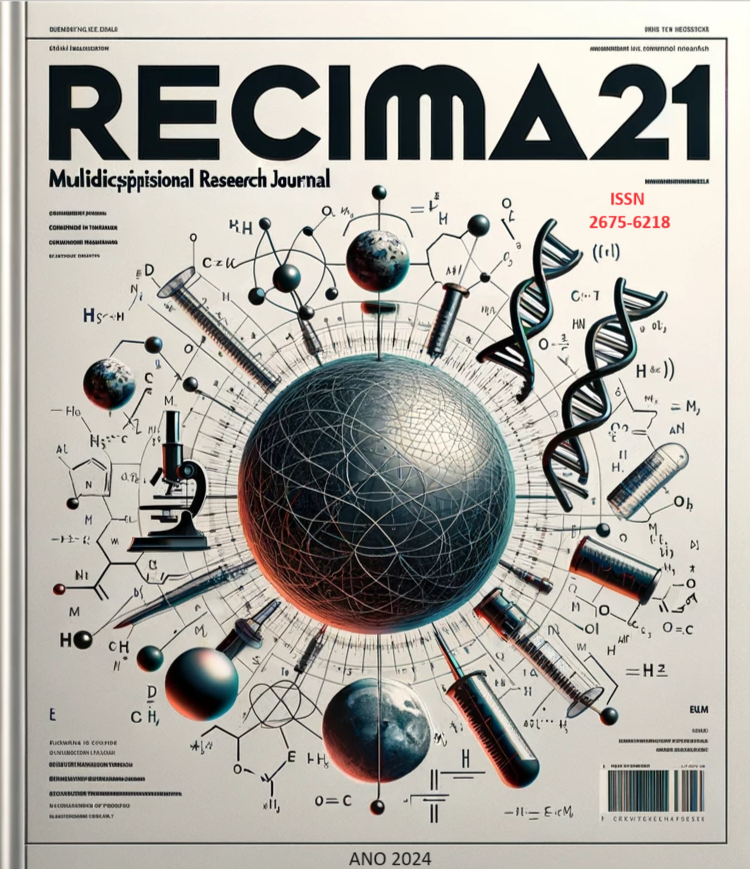DESAFIOS E AVANÇOS NO TRATAMENTO DA PARALISIA CEREBRAL INFANTIL: UMA REVISÃO BIBLIOGRÁFICA
DOI:
https://doi.org/10.47820/recima21.v5i2.4851Palavras-chave:
Criança, Paralisia Cerebral, TerapêuticaResumo
A Paralisia Cerebral Infantil (PC) constitui uma das condições neurológicas mais prevalentes e desafiadoras que afetam a infância. Objetivo: Essa revisão tem como objetivo analisar os desafios e avanços no tratamento da PC. Metodologia: Trata-se de uma revisão bibliográfica, utilizando artigos presentes nas seguintes bases de dados: PubMed, Scopus e SciELO Foram incluídos artigos originais e revisões sistemáticas em inglês e português publicadas entre 2019 e 2024, que abordassem sobre os desafios e avanços no tratamento da Paralisia Cerebral. Após a análise, foram selecionados 14 artigos para a confecção dessa revisão bibliográfica. Resultados e Discussão: foi observada a importância de abordagens integradas e personalizadas que incorporam as nuances clínicas da PC. Destaca-se também a necessidade de individualização no tratamento da PC, considerando a diversidade clínica dos pacientes. A compreensão crescente da neuroplasticidade sugere que estratégias centradas na adaptação cerebral podem ser fundamentais, e a integração de tecnologias assistivas deve ser realizada com equilíbrio, considerando aspectos éticos e práticos. Conclusão: A busca contínua por estratégias terapêuticas eficazes, baseadas em evidências sólidas, é crucial para avançar em direção a uma abordagem mais eficiente e compassiva na gestão desta condição neurológica complexa.
Downloads
Referências
ARANEDA, R et al. “Functional, neuroplastic and biomechanical changes induced by early Hand-Arm Bimanual Intensive Therapy Including Lower Extremities (e-HABIT-ILE) in pre-school children with unilateral cerebral palsy: study protocol of a randomized control trial.” BMC neurology vol. 20,1 133. 14 Apr. 2020. DOI: https://doi.org/10.1186/s12883-020-01705-4
ARNONI, Joice Luiza Bruno et al. Nonimmersive virtual reality as complementary rehabilitation on functional mobility and gait in cerebral palsy: A randomized controlled clinical trial. Games for Health Journal, v. 10, n. 4, p. 254-263, 2021.
FANDIM, Junior Vitorino et al. Effectiveness of virtual reality in children and young adults with cerebral palsy: a systematic review of randomized controlled trial. Brazilian journal of physical therapy, v. 25, n. 4, p. 369-386, 2021. DOI: https://doi.org/10.1016/j.bjpt.2020.11.003
FOSDAHL, Merete Aarsland et al. Stretching and progressive resistance exercise in children with cerebral palsy: a randomized controlled trial. Pediatric Physical Therapy, v. 31, n. 3, p. 264-271, 2019. DOI: https://doi.org/10.1097/PEP.0000000000000616
JACKMAN, Michelle et al. Interventions to improve physical function for children and young people with cerebral palsy: international clinical practice guideline. Developmental Medicine & Child Neurology, v. 64, n. 5, p. 536-549, 2022. DOI: https://doi.org/10.1111/dmcn.15055
LLAMAS-RAMOS, Rocío; SÁNCHEZ-GONZÁLEZ, Juan Luis; LLAMAS-RAMOS, Inés. Robotic systems for the physiotherapy treatment of children with cerebral palsy: a systematic review. International Journal of Environmental Research and Public Health, v. 19, n. 9, p. 5116, 2022. DOI: https://doi.org/10.3390/ijerph19095116
LV, Zhongyue et al. Safety and efficacy outcomes after intranasal administration of neural stem cells in cerebral palsy: a randomized phase 1/2 controlled trial. Stem Cell Research & Therapy, v. 14, n. 1, p. 1-14, 2023. DOI: https://doi.org/10.1186/s13287-022-03234-y
LIANG, Xianrong et al. Effectiveness of exercise interventions for children with cerebral palsy: A systematic review and meta-analysis of randomized controlled trials. Journal of rehabilitation medicine, v. 53, n. 4, 2021. DOI: https://doi.org/10.2340/16501977-2772
MCCOY, Sarah Westcott et al. Physical, occupational, and speech therapy for children with cerebral palsy. Developmental Medicine & Child Neurology, v. 62, n. 1, p. 140-146, 2020. DOI: https://doi.org/10.1111/dmcn.14325
POOL, Dayna et al. Locomotor and robotic assistive gait training for children with cerebral palsy. Developmental Medicine & Child Neurology, v. 63, n. 3, p. 328-335, 2021. DOI: https://doi.org/10.1111/dmcn.14746
SZTURM, Tony et al. Game-Based Dual-Task Exercise Program for Children with Cerebral Palsy: Blending Balance, Visuomotor and Cognitive Training: Feasibility Randomized Control Trial. Sensors, v. 22, n. 3, p. 761, 2022. DOI: https://doi.org/10.3390/s22030761
SHIH, Tsai-Yu et al. Comparative effects of kinect-based versus therapist-based constraint-induced movement therapy on motor control and daily motor function in children with unilateral cerebral palsy: a randomized control trial. Journal of NeuroEngineering and Rehabilitation, v. 20, n. 1, p. 13, 2023. DOI: https://doi.org/10.1186/s12984-023-01135-6
TOLDI, James; ESCOBAR, Joseph; BROWN, Austin. Cerebral palsy: Sport and exercise considerations. Current sports medicine reports, v. 20, n. 1, p. 19-25, 2021. DOI: https://doi.org/10.1249/JSR.0000000000000798
ZANON, Marcia Andrea et al. Neurodevelopmental treatment (Bobath) for children with cerebral palsy: a systematic review. Journal of child neurology, v. 34, n. 11, p. 679-686, 2019. DOI: https://doi.org/10.1177/0883073819852237
Downloads
Publicado
Licença
Direitos de Autor (c) 2024 RECIMA21 - Revista Científica Multidisciplinar - ISSN 2675-6218

Este trabalho encontra-se publicado com a Licença Internacional Creative Commons Atribuição 4.0.
Os direitos autorais dos artigos/resenhas/TCCs publicados pertecem à revista RECIMA21, e seguem o padrão Creative Commons (CC BY 4.0), permitindo a cópia ou reprodução, desde que cite a fonte e respeite os direitos dos autores e contenham menção aos mesmos nos créditos. Toda e qualquer obra publicada na revista, seu conteúdo é de responsabilidade dos autores, cabendo a RECIMA21 apenas ser o veículo de divulgação, seguindo os padrões nacionais e internacionais de publicação.













